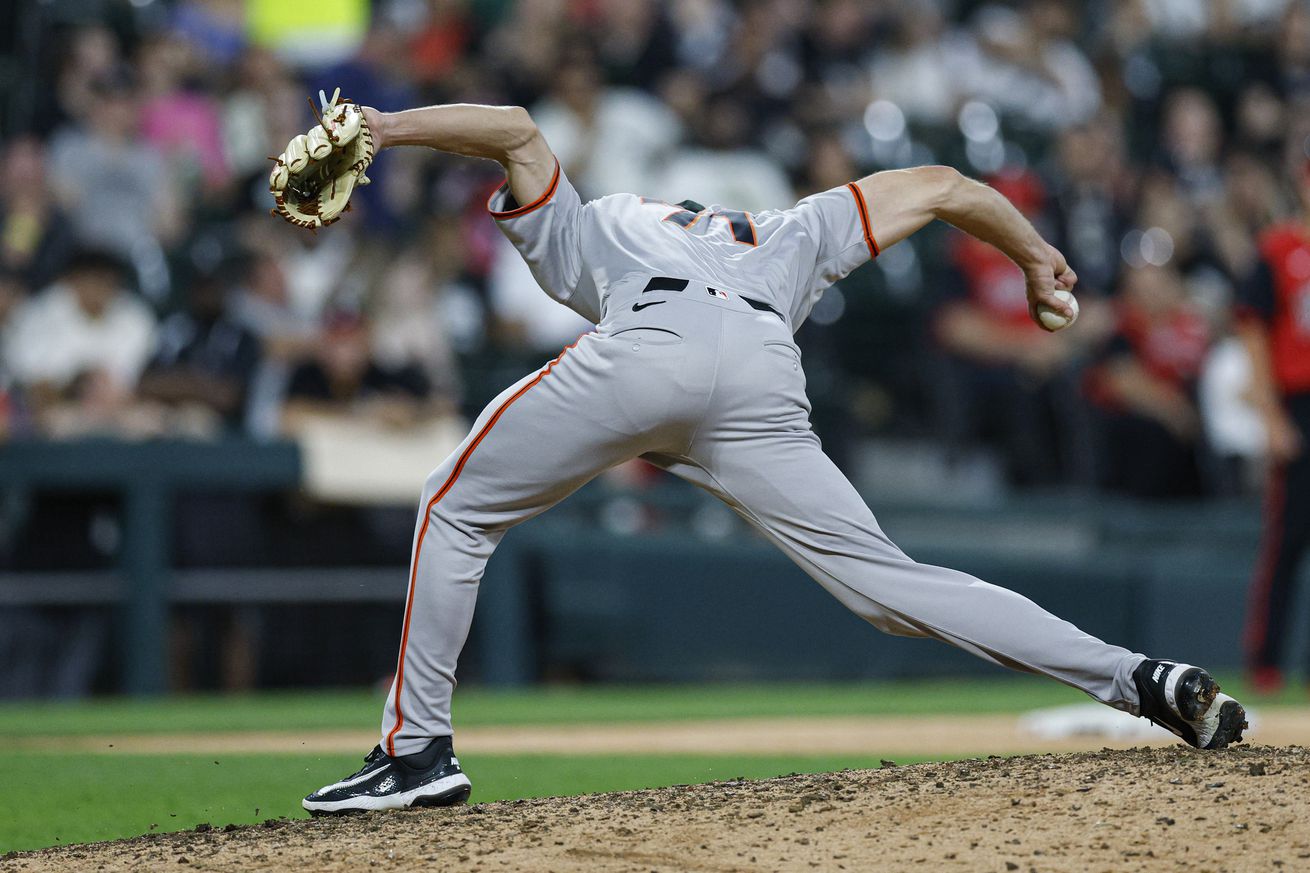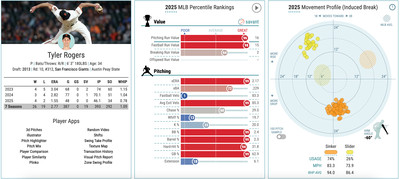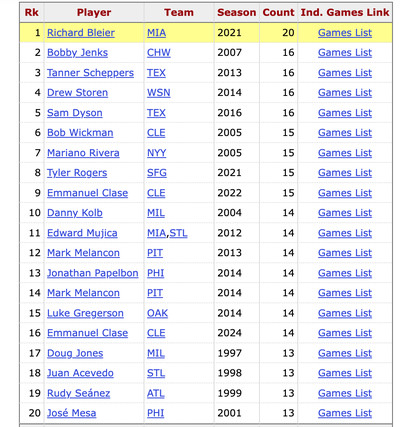
In praise of our favorite non-All Star reliever, and the value of the “quick inning”
Tyler Rogers has been one of the best relievers in baseball going on five years now. He’s a can of chicken noodle soup in a cupboard full of perishables, flavors of the month, flashes in the pan. In one sense, he’s the J. Alfred Prufrock of baseball, watching all the frivolities of modern baseball pass him by, all the triple-digit velocity flamethrowers burning out, coming and going, talking of Michelangelo.
Even as a 34-year old and seven-year veteran, that must wear on him. Whatever forced praise directed his way is propped up with undertones of anomaly and quirky and doesn’t really count. The faceless They question the very core of his game, marveling-slash-mocking ‘How his arms and legs are thin!’ — that not-so subtle implication heard loud and clear. He doesn’t throw fast enough. He’s too reliant on poor contact. His whiff-rate is too low to be counted on as a bona-fide closer.
Pitching is a lowly endeavor already. The life of a late-inning submarine reliever is even more isolating. Every time Rogers takes the mound, he must shut out the exterior criticisms, then mute the interior monologue running through his own consciousness. That current of doubt: Do I dare… Do I dare disturb the universe? as he unfurls his limbs, bending down, scraping his knuckles against the ground…
What about Tyler Rogers? Giants among those miffed by Misiorowski’s All-Star nod www.sfchronicle.com/sports/giant…
— Susan Slusser (@susanslusser.bsky.social) 2025-07-12T23:17:22.440Z
I imagine, during this week especially when the All Star Game shoves all the real and marketable stars (deemed worthy by Manfred) onto one diamond for a soulless day of glad-handing and butt-patting, Rogers watches the game from his couch in Colorado, seeing a line-up, not of intimidating All-Stars, but his own career highlight reel — hitter after professional hitter he’s made look like a fool all in one place.
(Note: I went through Rogers’ numbers, dating back to 2021, facing off against the AL’s All-Star starting line-up. Not a huge sample size, but a telling one: the All Stars are 1-for-10, with a single and 3 strikeouts.)
If the All-Star Break is an opportunity to see all your favorite baseball stars in action, then I’ll gladly skip the game and peruse Rogers’s Baseball Savant page instead.

The biographical and statistical overview is a banner of wonderful weirdness and contradictions. Despite his 83 MPH fastball velocity being in the 1-percentile, meaning the slowest in the league, while his fastball’s 15 Run Value is in the 98th percentile. The movement profile on his pitches are so far away from league average that the graphic looks like it was actually posted upside down, even reversed. How does his slider slide up? The figure illustrating his -60 degree arm angle looks more like a professional bowler, while his banner photo looks more like a bald eagle with an inverted color scheme than a pitcher mid-delivery. And where the heck is Austin Peay State?
Tyler Rogers now has a 1.55 ERA on the year after a scoreless inning against the Dodgers. There are only 3 qualified relievers in the NL with a better ERA, and 2 of them (Randy Rodríguez, Erik Miller) are his teammates.
The innings total, the ERA and xERA, the strikeout to walk ratio — there are plenty of tangible results we can point to as proof of Rogers’s excellence. My personal favorite stat of his is how many innings he’s completed by throwing 9 pitches or less. He’s done it 12 times so far this season (25% of his 48 appearances), the next highest total is 8 games.

Let’s call this stat a “quick inning.” It’s possible for a reliever to throw a quick inning and still give up six runs, but more often than not, it’s pretty clean. For Rogers, across those 12 different innings in which he needed 9 pitches or less to retire three opposing hitters, he allowed just one hit. No deep counts, no walks or hit-batters, no extra base hits, no runs scored, no stress. It’s hard to overvalue a shutdown frame like that from Rogers considering he generally takes the mound when the game is late and close and a Giants lead hangs in the balance, or a tie needs to be preserved, or a slim deficit needs to be managed.
The brief for the pitcher in those scenarios is to deflate egos, neutralize momentum, knock opponents back on their heels and get your players back in the dugout as quickly as possible so they can spend their energy on hitting rather than fielding. From a mental standpoint, high leverage relievers want outs to feel inevitable to their opponents, and nothing achieves that emotional devastation quite like a half-inning that lasts as long as a Taco Bell commercial.
11 of Rogers’s quick innings have come in the 8th inning. The Giants are 10 – 2 in games in which Rogers logs a quick inning. His shortest outing, needing just four pitches, maintained a 0-0 tie against the A’s that ended in the 10th with Wilmer Flores’s walk-off walk. Three of these innings have come against the Athletics, and they also seem to come in bunches: Rogers has paired quick innings in the same series four times. He’s needed just six pitches or fewer five different times, which also leads the Majors.
This isn’t a new phenomenon for Rogers either. Since 2021, when he established himself as a staple of the bullpen in his age-30 season, he’s thrown 51 “quick innings”. Another figure that leads the Majors while setting him apart considerably from his peers.

The single-season record for quick innings was set by Miami’s southpaw Richard Bleier in 2021 with 20. The specialization of relievers, recent rule-changes and the overall trend of limiting their in-game workload to single frames explains why this quick inning leaderboard is peppered with 21st century seasons, and Rogers is primed to tag his name all over it.

As you can see, Rogers’s personal best is 15, also in 2021 (also tied with Mariano Rivera). If he maintains his quick inning rate of roughly 1 every 4 appearances after the break (or 1 in every 4 IP), while matching his inning total from last season (70.1 IP, he’s at 46.1 right now), he’ll reach 18 quick innings this year. If he maintains said rate and matches 2021’s workload of 81 innings (a possibility if the Giants continue to play close games), he could match and even pass Bleier’s mark of 20 by year’s end.
The “quick inning” — add it to the list of “inside baseball” baseball stuff Rogers excels at. Its the “weird” that makes him so good and so easily dismissed by the baseball establishment. He might not get an All-Star nod, but the awkward hacks, the impossibly weird contact, and the overall results are undeniable.
Facing Rogers must be like being lulled into a dream-state for a hitter. It’s a brief sojourn into the Bizarro world where everything is backwards and upside down and nothing moves as it ought to and they are suddenly and aggressively bad at hitting a baseball. In this golden age of stubborn swing paths and launch angle and torpedo bats and exit velocity, opponents can’t handle someone who pitches against the grain.